#Ascomycete Fungi
Text

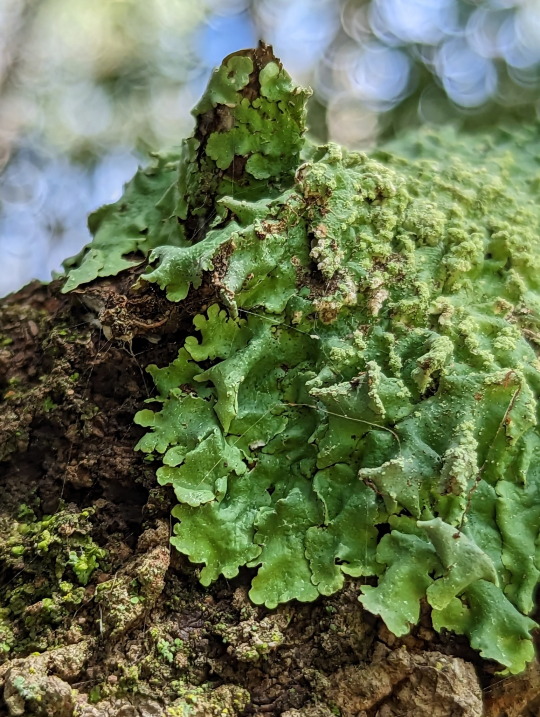






Shield Lichens
Unidentified, subfamily Parmelioideae
24/03/23 - NSW, Dapto
#Parmelioideae#unidentified#Typical Shield Lichens#Lecanoromycetes#Common Lichens#lichen#Pezizomycotina#Higher Ascomycetes#Ascomycota#Ascomycete Fungi#fungi#fungus#mycology
121 notes
·
View notes
Text
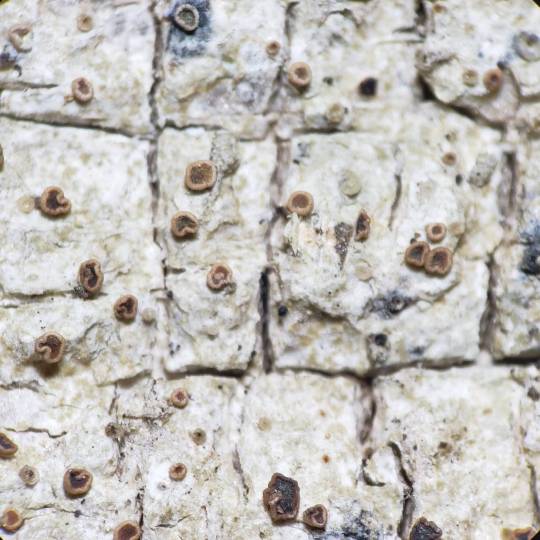
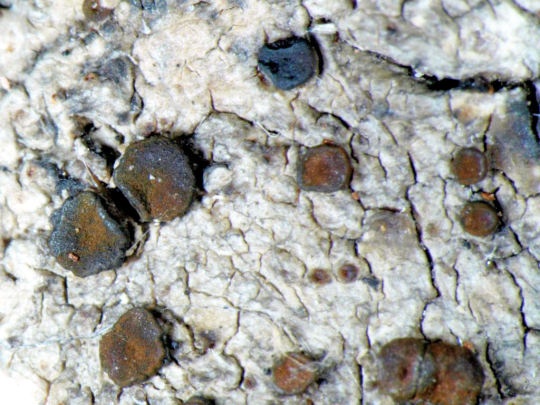




Huneckia pollinii
I am teaching a lichen ID course at the moment and feel like I have to keep reiderating "yeah these lichen features on consistent! . . . until they aren't." And reading the description for Huneckia pollinii is giving me mad consistent-until-it-is-not vibes. This lichen has a thin, crustose thallus of ashy-white to dark gray that can have an inconspicuous, immersed thallus or a more prominent cracked or warted thallus. It is sometimes surrounded in a dark prothallus. It has tiny, yellow or rusty red-brown or dark blackish-brown apothecia. These can reach sizes up to 1.3 mm across, but can also be much smaller (0.3-0.5 mm across) if H. pollinii is growing on small twigs. But it can also grow on the larger branches and trunks of smooth-barked deciduous trees (and even bone, apparently?!), and while I see 2 conflicting reports that suggest they prefer warm-temperate OR Arctic habitats, there's a good chance it grows in a bunch of different habitats but is easily overlooked or misidentified due to its small size. So yeah. Something is true until it isn't. Welcome to biology, or I guess science in general.
images: source | source
info: source | source
#lichen#lichens#lichenology#lichenologist#mycology#ecology#biology#phycology#symbiosis#symbiotic organisms#algae#fungus#fungi#ascomycete#Huneckia pollinii#Huneckia#trypo#trypophobia#life science#environmental science#natural science#nature#the natural world#beautiful nature#weird nature#I'm lichen it#lichen a day#daily lichen post
28 notes
·
View notes
Photo
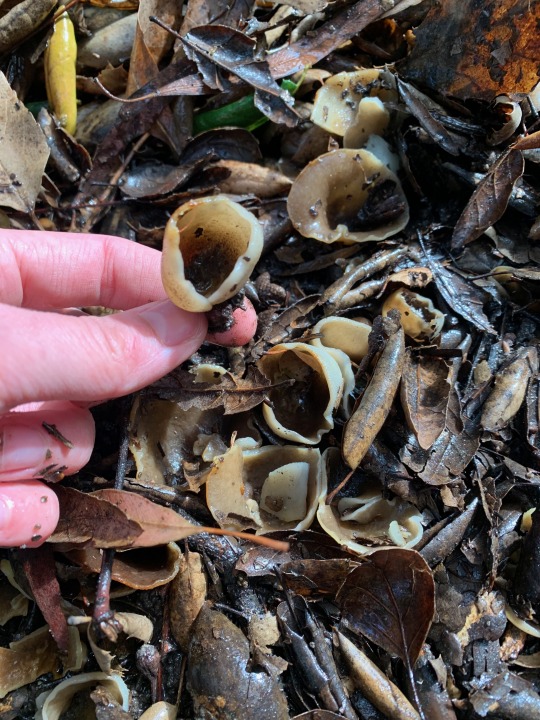
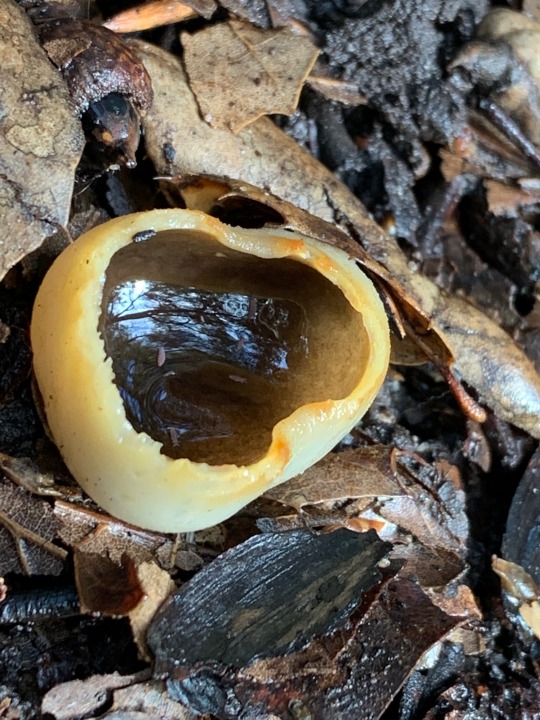
Cup fungi with reflections of the forest
#cup fungi#reflection#tw trypophobia#trypophobia#mushrooms#mushroom#ascomycete#fungus#fungi#mycology#mushroom hunting#fungal survey#raindrops
69 notes
·
View notes
Text
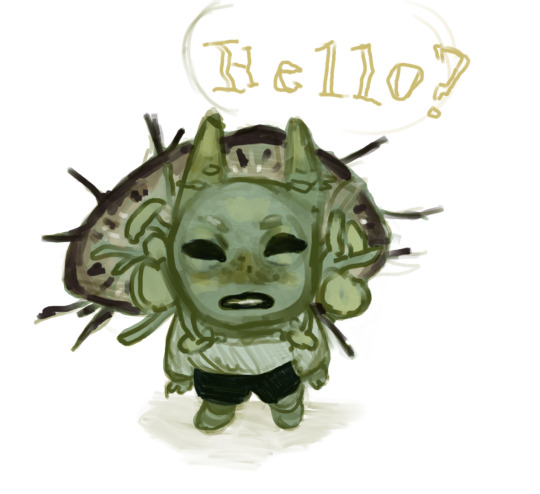
What if the Ascomycete elder god was just a lil’ lichen guy. A littol boy. What if I misidentified the lichen I collected and based his hat on so how’s it’s just a vague *parmelia*. Which is ok. It’s fine. I misidentified it bc the inside was the color of a cheeto.
Anyway his horns are *Cladonia sp.* and the ones around his face are *Niebla sp.*
#fungi elder gods#old gods#fungi#ascomycetes#lichen#lichen boy#I love him#he is my beautiful baby#dnd character#boy#summon an old god they said#it’ll bring about the end of days they said
14 notes
·
View notes
Photo






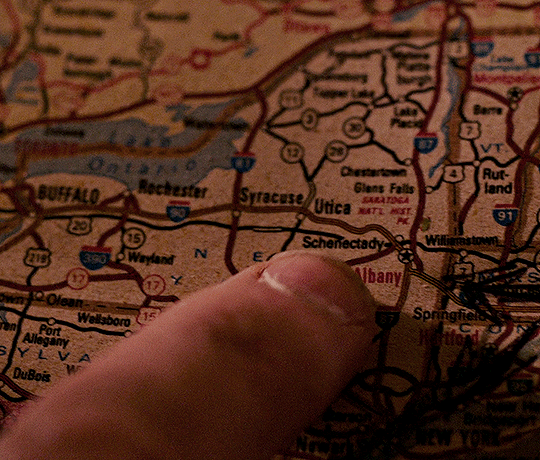

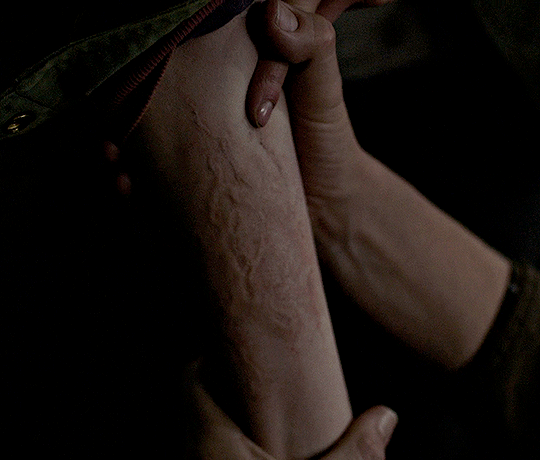

True, fungi cannot survive if its host’s internal temperature is over 94 degrees. And currently, there are no reasons for fungi to evolve to be able to withstand higher temperatures. But what if that were to change? What if, for instance, the world were to get slightly warmer? Well, now there is reason to evolve. One gene mutates and an ascomycete, candida, ergot, cordyceps, aspergillus, any one of them could become capable of burrowing into our brains and taking control not of millions of us, but billions of us. Billions of puppets with poisoned minds permanently fixed on one unifying goal: to spread the infection to every last human alive by any means necessary. And there are no treatments for this. No preventatives, no cures. They don’t exist. It’s not even possible to make them.
So, if that happens?
We lose.
THE LAST OF US (2023-)
1.01 "When You're Lost in the Darkness" | dir. Craig Mazin
#tlouedit#tlouhboedit#thelastofusedit#the last of us#dailyflicks#cinematv#tvedit#cinemapix#tvfilmsource#adaptationsdaily#usermandie#usermali#userconstance#usergal#the last of us hbo#tlou#myedits#tw flashing#the last of us spoilers
5K notes
·
View notes
Photo





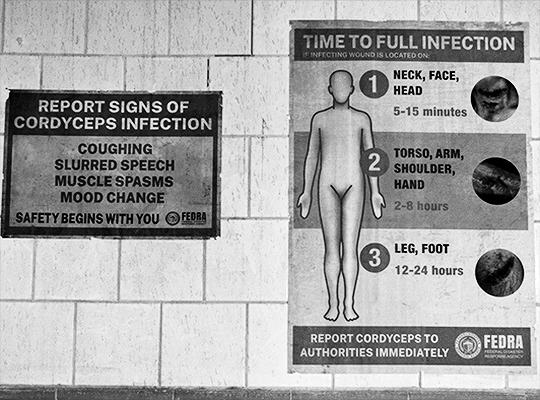



True, fungi cannot survive if its host’s internal temperature is over 94 degrees. And currently, there are no reasons for fungi to evolve to be able to withstand higher temperatures. But what if that were to change? What if... for instance, the world were to get slightly warmer? Well, now there is reason to evolve. One gene mutates and an ascomycete, uh, candida, ergot, cordyceps, aspergillus, any one of them could become capable of burrowing into our brains and taking control not of millions of us, but billions of us. Billions of puppets with poisoned minds permanently fixed on one unifying goal: to spread the infection to every last human alive by any means necessary. And there are no treatments for this. No preventatives, no cures. They don’t exist. It’s not even possible to make them.
So if that happens?
We lose.
THE LAST OF US
— 1.01 “When You’re Lost in the Darkness”
#tlouhboedit#the last of us#the last of us hbo#tlou hbo#tlou#tloudaily#cinemapix#cinematv#filmtv#tvandfilm#dailyflicks#paletmblr#userpastel#palesources#giffingpale#televisiongifs#dailytvfilmgifs#tvedit#tvgifs#mine
524 notes
·
View notes
Photo
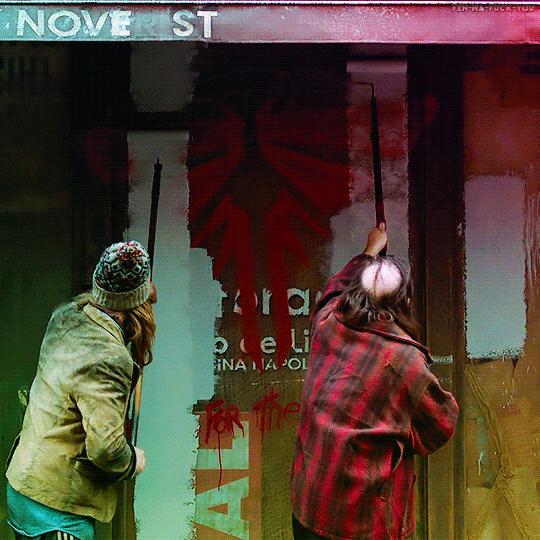





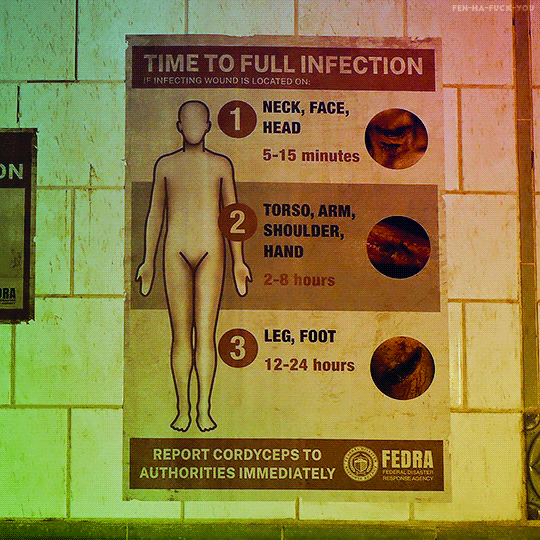

THE LAST OF US - When You're Lost in the Darkness
There are some fungi who seek not to kill, but to control. One gene mutates and an ascomycete, candida, ergot, cordyceps, aspergillus, any one of them could become capable of burrowing into our brains and taking control not of millions of us, but billions of us. Billions of puppets with poisoned minds permanently fixed on one unifying goal: to spread the infection to every last human alive by any means necessary. And there are no treatments for this. No preventatives, no cures. They don't exist. It's not even possible to make them. So if that happens? We lose.
#tlouhboedit#tlouedit#the last of us#the last of us hbo#tvedit#my gifs#spoilers#the last of us spoilers#cw body horror
114 notes
·
View notes
Note
Hey I’m the op from the lichen poll thingy, I really love all the wonderful tags everyone is putting in there and so curious to learn more. Didn’t know a lot about lichen before this, can only ID like 3 of them (wanted to write species but that’s not correct I assume?), so would you care to elaborate what you mean by your tags? Would love to learn!
HELL YES. I hope ur cool w/ me posting this publicly, I take any opportunity I can to gush about lichens. For reference, my tags on that poll were something along the lines of: "do YOU challenge the foundational concept of a species in western science with your existence? well you actually do but not as directly as a lichen." I'm not going to properly cite myself here because I'm lazy so take some things with a grain of salt, but BASICALLY:
- a lichen is a symbiotic relationship between a fungi (typically an ascomycete, though there are a few basidiomycete lichens) and a photosynthetic organism (usually green algae, sometimes cyanobacteria)
- the way we classify lichens, taxonomically, is based on their fungal part, also called a mycobiont. so the species name of a lichen - let's take my fruticose friend Usnea longissima for example - refers only to that fungal part.
- getting a positive species ID on that photosynthetic partner, also called a photobiont, is a lot harder, but we know that there's some overlap between the species of photobionts that different lichen employ
- so why don't we just refer to a lichen based on the mycobiont exclusively?
- because without the photobiont, the mycobiont will not grow into a lichen in any recognizable way. a lichen is NOT a lichen if it is just the fungi species it is named for, and it is not a lichen if it is just free-living algae.
- isn't it cool that some forms of life literally cannot exist as individuals? their existence is predicated on the fact that they are in partnership, inextricably linked from what our conventions of species differentiation would consider an entirely different organism. except, wait: so are we.
- human beings literally cannot function without the bacteria, fungi, and countless other microorganisms living in our intestines, on the surface of our skin, and just about everywhere else. i believe current literature states that >50% of the cells comprising the average human body are nonhuman. your microbiome is the reason you aren't just a tube that constantly leaks out partially-dissolved food matter!
- so who's to say that humans even exist as a distinct species? from a certain perspective, a human being is just an organic scaffold that houses a community of billions of individuals.
- get out there and appreciate your local lichens!!!
#also it's totally okay to refer to the lichens u know how to id as species#while not technically correct it's the framework by which we (people in western science) categorize and recognize them#i just think that biology should be more anarchist on a philosophical level#also ty for asking!!! i love love love to talk about lichens as mentioned previously
14 notes
·
View notes
Text


oh thank god a nice easy set...
ASCOMID is a actually a monster borrowed from Dungeons & Dragons, itself derived from the fungus phylum, Ascomycota, known commonly as "sac fungi" or "ascomycetes" known for their distinctive bursting spore sacs. In D&D they are specifically just giant fungal orbs that roll around passively but spraying infectious spores at any signs of life in the attempt to propagate themselves.
MAD GASSER would appear to be an super obtuse reference to the unsolved mystery of the 1940s serial assailant of Mattoon Illinois(?) in which a variety of people reported an unusual smell in their homes before succumbing to paralysis, labored breathing, coughing, nausea, and then unconsciousness. There was never a suspect or any clear means or motive established and the incidents were largely chalked up to mass hysteria. (Oh it was a monster in some SMT games too, so clearly there's some popculture awareness of it... Weird...)
MOLD FUNGUS appears to just be the two words slapped together. But molds are fungi so it's kind of redundant.
Then there's KESARAN PASARAN, which I've rambled a bit about before: "It's a kind of folk creature(?) said to be a fluffy white ball that multiplies when you aren't looking(hence their appearance and ability in game) kind of like 'Angel Hair' in western superstition. It is consequently the Japanese word for dandelion puffs." I dunno why WA4 opted to reskin them and make them gross and weird looking
(They're not related to the ASCOMID line, but they're round, they're a WA3 prologue enemy, and they're unrepresented in the WA bestiary, sp I'm slapping them in here. )
HIDDEN BOMB, actually just called HIDE BOMB in Japanese, are oddly enough a specific reference to a weapon in Mobile Suit Gundam and not just self descript. The Zeon mobile suit, YMS-15 Gyan used floating/projectile mines deployed from its signature shield called Hide Bombs.
SPHERE is just a sphere... What do you want from me? Honestly I kinda wish they'd done the texture with no faces at all, that feels like it would have been funnier


4 notes
·
View notes
Note
about how many different types of mushrooms have you taken photos of?
Oh my, so many. If you mean species, then at least a hundred. If you mean types like categories, then I've taken photos of boletes (many different boletus, leccinum and suillus species), chanterelles, polypores, ascomycetes (sac fungi), puffbals and a neverending list of gilled mushrooms like dozens of russula sp., amanita, agaricus, lepiota, lactarius, armillaria, clitocybe, lepista, hygrocybe, tricholoma, hypholoma, mycena etc.
32 notes
·
View notes
Text
Here are some neat mushrooms I met during a recent group foray!
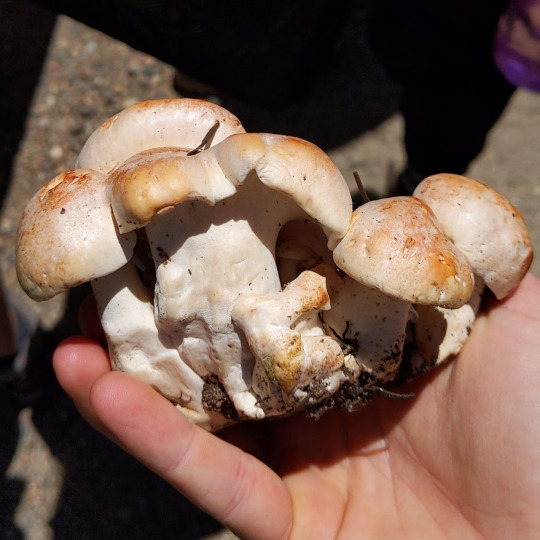
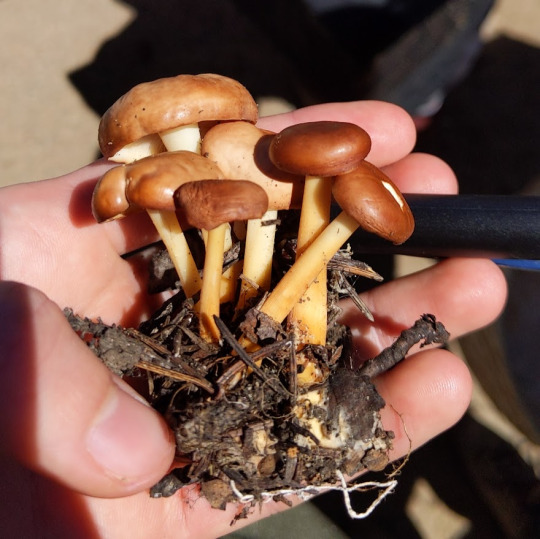
Left: Albatrellus confluens (sheep polypore) -- an edible polypore that's shaped like a mushroom instead of a shelf. Some say they smell like Froot Loops!
Right: Rhodocollybia butyracea -- When fresh, the caps on these mushrooms have a butterlike smooth greasiness (thus the name).


Left: Cudonia sp. (circinans?) These are ascomycetes, meaning they're more closely related to cup fungi. The mycologist leading the foray claimed this cluster I found for his collection!
Right: Making an unexpected summer appearance, it's Flammulina velutipes, the wild version of the cultivated enoki! The darkened foot of the "stipe" (stem) has a delightful velvety texture.


Left: Trichaptum subchartaceum -- From above, it's shades of white and gray, but the pore surface of this polypore is a striking lilac!
Right: Lactarius sp. (maculatipes or similar) I'm holding this one upside-down so you can really appreciate all the features that make it weird: A "scrobiculate" (pitted) stipe and an intensely "viscid" (slimy) coating on its stipe and cap. As a bonus, this guy is SPICY -- a tiny nibble (spat back out rather than swallowed) left the tip of my tongue completely numb.
#it's an intensely buggy year this year so unfortunately nothing hypothetically edible i found was actually in an edible condition#but i got to spend five hours stomping around aspen groves and meadows and spruce forests#with a bunch of fellow nature nerds#so needless to say i had a great time#mycology#mushrooms#fungi#foraging#my posts
4 notes
·
View notes
Photo
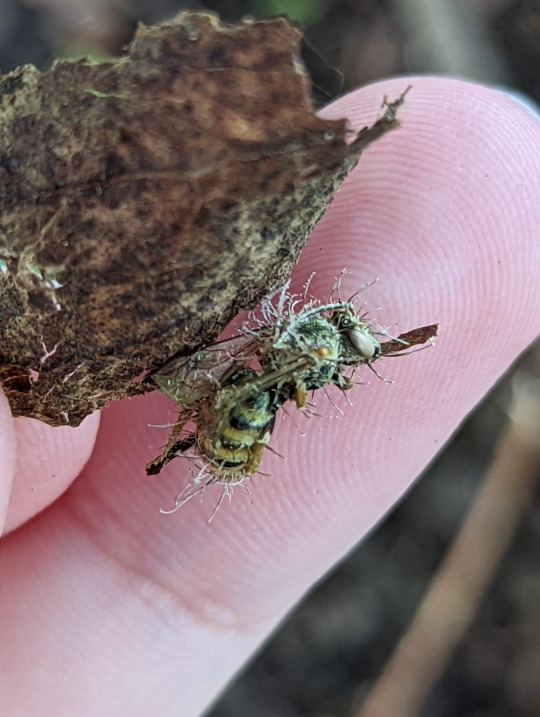

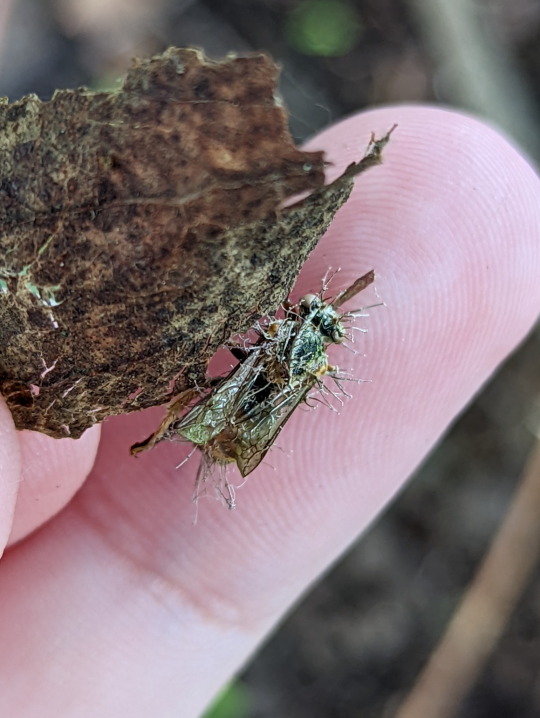
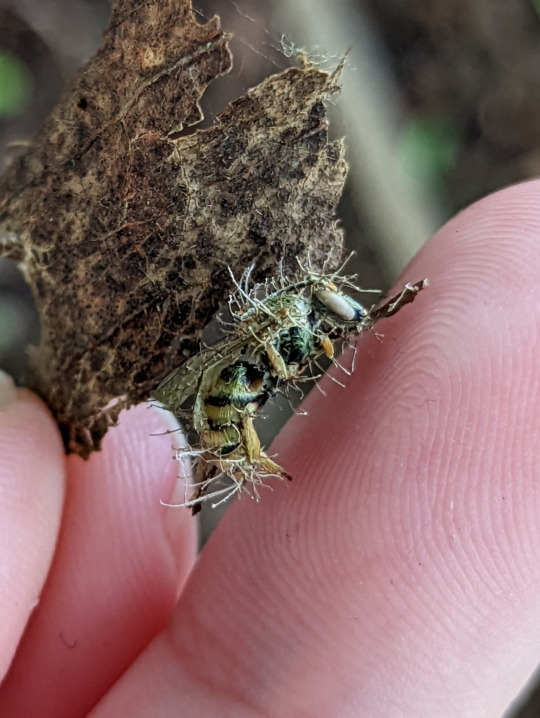
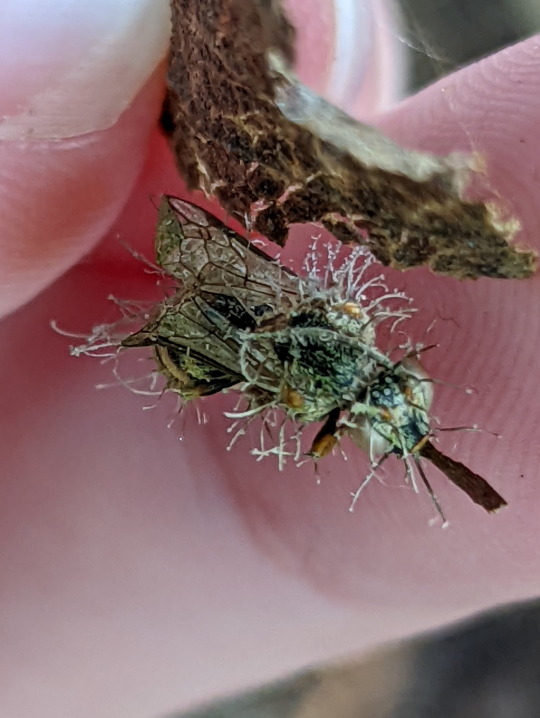

Hymenopteran Insect Infested with Fungi
Unidentified, class Sordariomycetes
31/08/22
#Sordariomycetes#Unidentified#hymenoptera#parasitism#parasitic fungi#Ascomycota#Ascomycete Fungi#Pezizomycotina#Higher Ascomycetes#mycology#fungi#fungus#entomophagy#bugs#bugblr#bugs tw#bug#insectblr#insects#insect#insecta#insects tw#entomology#Arthropods#Arthropoda#invertebrates#invertblr
172 notes
·
View notes
Text
Lichen anatomy lesson
SO I was reading through this week’s paper for my lab meeting, and I noticed it had some great visuals that explain the internal anatomy of the lichen thallus--specifically for this paper, Lobaria pulmonaria. So, here is what we see with the naked eye:

Lobaria pulmonaria is a large, foliose lichen that grows in undisturbed, old growth forests. It is a symbiotic association between an ascomycete fungus (the mycobiont), a photosynthesizing green algae (the primary photobiont), and a nitrogen-fixing cyanobacteria (the secondary photobiont). This means that L. pulmonaria is what is known as a tripartite lichen, which is pretty unique in the lichen world. If you were to cross section one of these leaf-like lobes and look at it under the microscope, here is what it would look like:

You can clearly see the structural and protective layers of fungal tissue in the upper and lower cortices and medulla, the green algal cells in the primary photobiont layer, and the cyanobacterial colonies encapsulated in the cephalodia. You can also see the tomentem. These little strings look like roots, but don’t absorb water or fix nitrogen like roots do--they just anchor the lichen to the substrate.
But let’s get even more granular:

In this schematic, you can see other members of the symbiotic community, including bacteria and lichenicolous fungi (I think it is important to note here that every living organism has colonies of associated bacteria and fungi. This is not unique to lichens). You can also see the structures that encapsulate the cyanobacteria, and as well as the make-up or soredia (vegetative reproductive propagules) containing both fungal and algal components.
Now I know some of you guys might be wondering why L. pulmonaria has 2 photobionts when many lichens get by with just 1. Well never fear, my symbiotic associates. I will let you know in a future lichen lesson, but for now enjoy these gorgeous graphics and bask in the glory of the lichen.
Grimm, M., Grube, M., Schiefelbein, U., Zühlke, D., Bernhardt, J., & Riedel, K. (2021). The lichens’ microbiota, still a mystery?. Frontiers in Microbiology, 714.
#lichen#lichens#lichenology#lichenologist#lichenized fungus#symbiosis#mutualism#biology#ecology#mycology#microbiology#algae#cyanobacteria#nature#the natural world
400 notes
·
View notes
Photo

The process of sorting stickers for my 20 pack of Vintage Mushroom Illustration Stickers. Every sticker is hand-cut by me and then sorted to make sure each pack has the right amount of diversity of mushroom species. Every single pack has two different Amanita muscaria stickers, Amanita jacksonii, and Cortinarius sanguineus. Each pack varies slightly but has a sampling of different types of mushrooms (Boletes, Morels, Cup Fungi, Coral Fungi Earth Stars, etc.) The sticker pack is currently available in my online shop!
#Cortinarius sanguineus#amanita muscaria#amanita jacksonii#amanita#mushrooms#mushroom species#mushroom#fungus#fungi#mycology#boletes#boletus edulis#morels#morel#cup fungi#earth stars#coral fungi#stinkhorns#basiodiomycetes#ascomycetes#basidiomycota#ascomycota#mushroom stickers#fungus queen#fungusqueen#fungus queen stickers#mycology stickers#fungi stickers#vintage scientific illustration#scientific illustration
72 notes
·
View notes
Note
Are fungi or mushrooms considered plants? I've heard mixed things & thought you'd have some insight about it. Really love ur ivy concepts!!
I’m not going to just say No! and move on because the truth (at least to me) is REALLY INTERESTING. I drew this out, here’s a few billion years summed up with jokes!
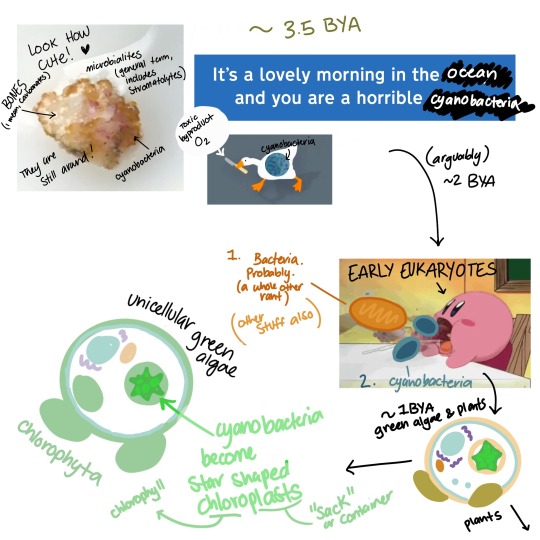
Ok. More than 3.5 BYA. You are a bacteria, living in the oceans (which are blood red but that’s a whole Other Thing). You are a cyanobacteria, you live in big gooey colonies with your best friends and you decide “hey, it would be cool if I could do photosynthesis and get even more energy after I eat the sugars” Which was generally considered a Bad Move, because you made oxygen at the end which is super toxic. To all life. Really bad decision (the oceans helped). Instead of wiping out all life by being horrible and toxic, you actually build the ozone layer and make way for a whole bunch of new guys who can use oxygen (oxygenic respiration).
Now we have eukaryotes depicted as Kirby. This is because they are Like That and when they ate cyanobacteria they didn’t always kill them, and over time they just became chloroplasts. Now they can do photosynthesis. The mitochondria was a similar process that happened first. Some plankton still do this and just… have a guy they didn’t eat all the way.
So we have eukaryote Kirby with chloroplasts. That will split to plants and green algae, here’s where the fungi come in!

The last common fungal ancestor was a parasite of a single called green algae or ancestor, things kind of overlap ranges. So you are a closer “cousin” to fungi than fungi are to plants!
I included this whole thing because I study lichens, and two of the partners in that symbiosis are fungi and/or cyanobacteria. That’s crazy! They were parasites and went and did their own thing and some decided to be symbiotic later! With plants too, they are still pathogens and parasites and so on but doesn’t it seem like living inside a thing that originated by eating all your shit would be a good idea. But lichens have lasted more than 400 million years so who am I to say. And plants have a lot of fungal pathogens but may not have made the transition to land without fungi and would not exist without them.
I could go on. This stuff is my main interest for my scientific career (paired down here ofc) hope this was more interesting than just saying “no!” : )
Bonus: mushrooms are ‘fruiting bodies’ or ‘basidia’ of one division of fungi, the basidiomycetes (buh-sid-ee-oh-my-seats)! ascomycetes (ass-co-my-seats) are usually the cup-shaped ones, not technically mushrooms. I think colloquially mushrooms is used for “edible” fungi and ‘toadstools’ are non-edible.
#asks#botany#fungi#fungi are not plants#they are worse#(affectionate)#green algae#endosymbiosis#chloroplasts#mushrooms#mycology#phycology#phytology
82 notes
·
View notes
Text
Mycelium Morphologies
There are many morphological presentations of mycelium, and each species and variety can have its own patterns of presentation.
Most commonly: rhizomorphic and tomentose, but also effuse, sectored, zonate and variable morphologies are used as descriptors in mycological research!
Mycelium is not an exclusive nutrient seeking colony for just basidiomycetes (most mushrooms), there are classifications of other fungi, ascomycetes and others (to include penicillium, trich, etc) that also have mycelium as part of their reproductive cycle. So, unfortunately sometimes to determine if random mycelial growth on an agar plate is your preferred/intended genetics or contaminant genetics.. you kind of have to wait, or know exactly what your preferred/expected mycelium looks and smells (if u smell test) like. Of course, microscopic confirmation is ultimate determinant if you are able to do so.
Here is link for that: DayTrippers Microscopy library of contam and healthy mycelium examples: https://www.reddit.com/r/ContamFam/comments/nnquol/microscopy_of_healthy_mycelium_and_contamination/
3 notes
·
View notes